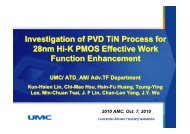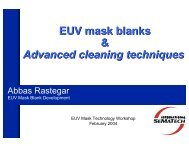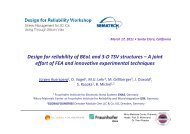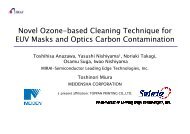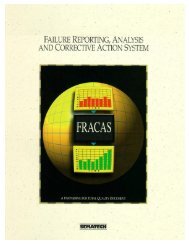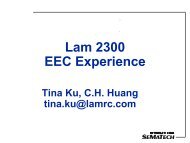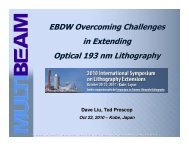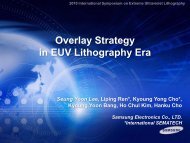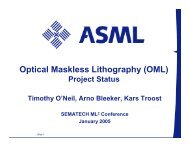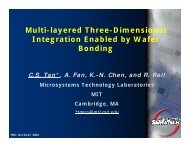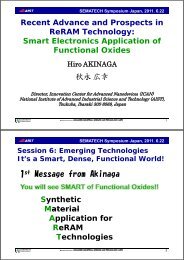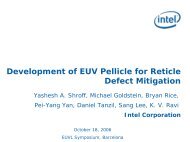High transmission EUVL pellicle development - Sematech
High transmission EUVL pellicle development - Sematech
High transmission EUVL pellicle development - Sematech
You also want an ePaper? Increase the reach of your titles
YUMPU automatically turns print PDFs into web optimized ePapers that Google loves.
<strong>High</strong> <strong>transmission</strong> <strong>EUVL</strong><br />
<strong>pellicle</strong> <strong>development</strong><br />
Yashesh A. Shroff, Pei-Yang Yan,<br />
Farhad Salamassi*, Eric Gullikson*<br />
2008 <strong>EUVL</strong> Symposium, Lake Tahoe<br />
Intel Corporation<br />
*Lawrence Berkeley Lab
Overview<br />
• Motivation &<br />
specs<br />
• Thermal modeling<br />
• <strong>High</strong> <strong>transmission</strong> prototype <strong>development</strong><br />
– Illumination non-uniformity<br />
• Full-scale <strong>pellicle</strong> HVM mechanical test<br />
• DUV/AIMS study<br />
• Summary &<br />
future work<br />
"<strong>EUVL</strong> Pellicle Development", Yashesh Shroff, Pei-Yang Yan, F. Salamassi, Eric Gullickson<br />
<strong>EUVL</strong> Symposium 2008, Lake Tahoe 2
Concept<br />
Square cell mesh<br />
Hexagonal cell mesh<br />
•The Concept<br />
– Thin film mounted on a wire-mesh<br />
– Mesh located “far” from reticle plane to defocus defects<br />
– Transmission requires a high percentage open area<br />
– Illumination uniformity requires partial coherence<br />
"<strong>EUVL</strong> Pellicle Development", Yashesh Shroff, Pei-Yang Yan, F. Salamassi, Eric Gullickson<br />
Stand-off height = 6 mm<br />
Mesh pitch<br />
• Mesh apodizes<br />
the illuminator<br />
exit pupil and<br />
PO entrance<br />
pupil.<br />
• Mesh film<br />
absorbs with<br />
both passes.<br />
<strong>EUVL</strong> Symposium 2008, Lake Tahoe 3
Motivation & Goal<br />
• The The aim aim of of this this research is is to to<br />
create create an an EUV EUV <strong>pellicle</strong> as as a<br />
backup to to <strong>pellicle</strong>-less operation<br />
– Operating Operating within within litho litho tool tool<br />
without without added added particles particles<br />
• Mesh Mesh based based <strong>pellicle</strong>’s target target<br />
performance:<br />
– EUV EUV <strong>transmission</strong>: <strong>transmission</strong>: double-pass<br />
double-pass<br />
loss loss < 30% 30%<br />
– Robustness: Robustness: HVM HVM capable capable<br />
operation operation<br />
– Imaging: Imaging: minimal minimal contrast contrast and and<br />
uniformity uniformity loss loss<br />
"<strong>EUVL</strong> Pellicle Development", Yashesh Shroff, Pei-Yang Yan, F. Salamassi, Eric Gullickson<br />
EUV Pellicle Specifications<br />
Frame<br />
length/width<br />
Height 5 mm<br />
149/122mm<br />
Transmission >70%<br />
Film thickness 50nm ± 2nm<br />
Illumination<br />
non-uniformity<br />
±0.6%<br />
Film stress Tensile ( 2000<br />
Stiffness 193nm frame<br />
<strong>EUVL</strong> Symposium 2008, Lake Tahoe 4
Overview<br />
• Motivation &<br />
specs<br />
• Thermal modeling<br />
• <strong>High</strong> <strong>transmission</strong> prototype <strong>development</strong><br />
– Illumination non-uniformity<br />
• Full-scale <strong>pellicle</strong> HVM mechanical test<br />
• DUV/AIMS study<br />
• Summary &<br />
future work<br />
"<strong>EUVL</strong> Pellicle Development", Yashesh Shroff, Pei-Yang Yan, F. Salamassi, Eric Gullickson<br />
<strong>EUVL</strong> Symposium 2008, Lake Tahoe 5
Thermal model<br />
Pellicle<br />
(25% EUV absorbed)<br />
Entrance<br />
Plane of PO<br />
Reticle: 5-20W*<br />
• Instantaneous power at slit can result in high thermal load.<br />
• Transient model is developed to calculate peak rise in <strong>pellicle</strong><br />
temperature<br />
* OoB power & IU <strong>transmission</strong> of EUV + OoB spectrum dependent<br />
"<strong>EUVL</strong> Pellicle Development", Yashesh Shroff, Pei-Yang Yan, F. Salamassi, Eric Gullickson<br />
Illuminator<br />
exit plane<br />
IF:<br />
180W<br />
<strong>EUVL</strong> Symposium 2008, Lake Tahoe 6
Cooling time<br />
Membrane Parameters:<br />
• Pellicle thickness, d = 50nm<br />
• Exposure slit area, A = 10cm 2<br />
• Exposure slit time, t = 10ms<br />
Constants<br />
• Si specific heat, c = 0.7J/g-k<br />
• Emissivity, ε<br />
= 0.5<br />
• Radiative loss, σ = 5.67e-12<br />
• Si density, ρ<br />
= 2.33g/cm3<br />
ΔT=0 cooling time (ms)<br />
Pellicle temp stabilization v/s input radiation<br />
40<br />
800<br />
0<br />
0 5 10 15 20 25<br />
Reticle incident power (W)<br />
0<br />
Q= c⋅m⋅ΔT<br />
∂Q<br />
= A⋅ε<br />
⋅σ⋅<br />
dt<br />
4 4 ( T − )<br />
env TSi<br />
"<strong>EUVL</strong> Pellicle Development", Yashesh Shroff, Pei-Yang Yan, F. Salamassi, Eric Gullickson<br />
35<br />
30<br />
25<br />
20<br />
15<br />
10<br />
5<br />
∂T ⎛ A⋅ε<br />
⋅σ⎞<br />
= ⎜−<br />
⎟T<br />
dt ⎝ c⋅m<br />
⎠<br />
Assumes 25% reticle incident power absorption by <strong>pellicle</strong><br />
<strong>EUVL</strong> Symposium 2008, Lake Tahoe 7<br />
Si<br />
4<br />
700<br />
600<br />
500<br />
400<br />
300<br />
200<br />
100<br />
ΔT initial temp rise (K)
Overview<br />
• Motivation &<br />
specs<br />
• Thermal modeling<br />
• <strong>High</strong> <strong>transmission</strong> prototype <strong>development</strong><br />
– Illumination non-uniformity<br />
• Full-scale <strong>pellicle</strong> HVM mechanical test<br />
• DUV/AIMS study<br />
• Summary &<br />
future work<br />
"<strong>EUVL</strong> Pellicle Development", Yashesh Shroff, Pei-Yang Yan, F. Salamassi, Eric Gullickson<br />
<strong>EUVL</strong> Symposium 2008, Lake Tahoe 8
Requirements for reaching <strong>pellicle</strong><br />
<strong>transmission</strong> limits<br />
•GOAL: total 2-pass <strong>transmission</strong>: 70%<br />
– Mesh <strong>transmission</strong>: 97%<br />
– Membrane <strong>transmission</strong>: 93%<br />
•Improving the mesh<br />
– Reduce linewidth: 1-3um<br />
– Increase pitch: 70-100um<br />
•Improving the membrane<br />
– Reliable membrane thickness of 50nm<br />
Lithographically define the line<br />
– Commercially available mesh min LW only ~10um<br />
– Improve robustness by increasing aspect ratio of mesh wires<br />
– Use Si: better thermal stability with membrane<br />
"<strong>EUVL</strong> Pellicle Development", Yashesh Shroff, Pei-Yang Yan, F. Salamassi, Eric Gullickson<br />
<strong>EUVL</strong> Symposium 2008, Lake Tahoe 9
Pellicle Process at LBNL<br />
1. Spin release layer on Si wafer.<br />
2. Deposit Si + Ru capping layer using<br />
magnetron sputtering.<br />
3. Spin on photoresist.<br />
4. Pattern mesh using contact<br />
lithography.<br />
5. Electroplate Ni mesh.<br />
6. Remove resist.<br />
7. Attach to frame and release from<br />
substrate.<br />
"<strong>EUVL</strong> Pellicle Development", Yashesh Shroff, Pei-Yang Yan, F. Salamassi, Eric Gullickson<br />
Pellicle 50 nm Si with 100<br />
micron pitch and 3 micron<br />
linewidth mesh. Average<br />
<strong>transmission</strong> at 13.5 nm is<br />
75.7%<br />
<strong>EUVL</strong> Symposium 2008, Lake Tahoe 10
Transmission results<br />
Membrane: 50nm Si + 2nm Ru<br />
cap with <strong>transmission</strong> = 84% @<br />
13.5 nm<br />
100 μm<br />
Linewidth Pitch Tmesh<br />
expected<br />
Tmesh<br />
measured<br />
T<strong>pellicle</strong><br />
measured<br />
"<strong>EUVL</strong> Pellicle Development", Yashesh Shroff, Pei-Yang Yan, F. Salamassi, Eric Gullickson<br />
Double-<br />
pass txm<br />
1 μm 35 μm 94% 94.5% 79.5% 63.2%<br />
1 μm 100 μm 98% 97.5% 81.9% 67.1%<br />
No mesh<br />
35 μm<br />
1<br />
0.8<br />
0.6<br />
0.4<br />
0.2<br />
0<br />
-4<br />
-2<br />
mm<br />
0<br />
Measured at LBNL synchtroton (λ=EUV)<br />
<strong>EUVL</strong> Symposium 2008, Lake Tahoe 11<br />
2<br />
100 μm<br />
4 -5<br />
35 μm<br />
0<br />
mm<br />
5<br />
0.8<br />
0.7<br />
0.6<br />
0.5<br />
0.4<br />
0.3<br />
0.2<br />
0.1<br />
0
Impact on reticle plane non-uniformity<br />
•Non-uniformity scales with mesh linewidth. Modeled results:<br />
Mesh1 Mesh2 Mesh3<br />
Linewidth (LW) 10u 3u 1u<br />
Pitch 250u 100u 35u<br />
Non-<br />
uniformity<br />
5mm 1.4% 0.25% 0.08%<br />
2mm 7.4% 0.50 0.14%<br />
Mesh only txm 94% 94% 98%<br />
•Decreasing stand-off distance dramatically impacts uniformity<br />
due to the severely increased apodization of the pupil by the<br />
mesh<br />
•We recommend minimum stand-off distance of 5mm,<br />
consistent with current DUV technologies.<br />
"<strong>EUVL</strong> Pellicle Development", Yashesh Shroff, Pei-Yang Yan, F. Salamassi, Eric Gullickson<br />
Pitch<br />
<strong>EUVL</strong> Symposium 2008, Lake Tahoe 12
Pellicle <strong>transmission</strong> improvement<br />
1<br />
0.9<br />
0.8<br />
0.7<br />
0.6<br />
0.5<br />
0.4<br />
0.3<br />
80nm Si membrane on 10/250um mesh<br />
2007<br />
2008<br />
0.2<br />
11 11.5 12 12.5 13 13.5 14 14.5 15<br />
wavelength (nm)<br />
"<strong>EUVL</strong> Pellicle Development", Yashesh Shroff, Pei-Yang Yan, F. Salamassi, Eric Gullickson<br />
Silicon deposition process<br />
improvement:<br />
- 6% increase in 1-pass<br />
<strong>transmission</strong><br />
- Measurement at LBNL<br />
synchrotron<br />
- Mesh linewidth/pitch:<br />
10μm / 250μm<br />
<strong>EUVL</strong> Symposium 2008, Lake Tahoe 13
Overview<br />
• Motivation &<br />
specs<br />
• Thermal modeling<br />
• <strong>High</strong> <strong>transmission</strong> prototype <strong>development</strong><br />
– Illumination non-uniformity<br />
• Full-scale <strong>pellicle</strong> HVM mechanical test<br />
• DUV/AIMS study<br />
• Summary &<br />
future work<br />
"<strong>EUVL</strong> Pellicle Development", Yashesh Shroff, Pei-Yang Yan, F. Salamassi, Eric Gullickson<br />
<strong>EUVL</strong> Symposium 2008, Lake Tahoe 14
Full-size <strong>pellicle</strong> <strong>development</strong><br />
• Lowest Si membrane thickness<br />
achieved: 70nm<br />
– Corresponds to 85% EUV txm<br />
• Mesh properties:<br />
– Linewidth: 10um<br />
– Pitch: 250um<br />
– Transmission: 91%<br />
"<strong>EUVL</strong> Pellicle Development", Yashesh Shroff, Pei-Yang Yan, F. Salamassi, Eric Gullickson<br />
<strong>EUVL</strong> Symposium 2008, Lake Tahoe 15
Full-size <strong>pellicle</strong> scan test<br />
Mechanical stability test to<br />
verify robustness.<br />
Repeated 6g acceleration, 2m/s scan<br />
velocity expected in 180WPH HVM<br />
system.<br />
• Vacuum environment chamber<br />
• Track length 75mm<br />
• 50min test, ramping from 1G6G<br />
– Continuous scan for 10’ at 6G,<br />
limited by motor reliability<br />
concerns<br />
• Full-size <strong>pellicle</strong>s tested:<br />
– 70nm membrane<br />
– 100nm membrane<br />
"<strong>EUVL</strong> Pellicle Development", Yashesh Shroff, Pei-Yang Yan, F. Salamassi, Eric Gullickson<br />
<strong>EUVL</strong> Symposium 2008, Lake Tahoe 16
position (mm)<br />
80<br />
60<br />
40<br />
20<br />
0<br />
-20<br />
-40<br />
-60<br />
Scan profile<br />
Position v/s time of <strong>pellicle</strong> scan<br />
forward scan<br />
reverse scan<br />
-80<br />
0 0.05 0.1 0.15<br />
time (sec)<br />
0.2 0.25 0.3<br />
"<strong>EUVL</strong> Pellicle Development", Yashesh Shroff, Pei-Yang Yan, F. Salamassi, Eric Gullickson<br />
scan velocity (m/s)<br />
4<br />
3<br />
2<br />
1<br />
0<br />
-1<br />
-2<br />
Velocity v/s time of <strong>pellicle</strong> scan<br />
forward scan<br />
reverse scan<br />
-3<br />
0 0.05 0.1 0.15<br />
time (sec)<br />
0.2 0.25 0.3<br />
<strong>EUVL</strong> Symposium 2008, Lake Tahoe 17
Scan test: 6G, continuous (100nm membrane on<br />
10um linewidth / 250μm pitch mesh)<br />
"<strong>EUVL</strong> Pellicle Development", Yashesh Shroff, Pei-Yang Yan, F. Salamassi, Eric Gullickson<br />
<strong>EUVL</strong> Symposium 2008, Lake Tahoe 18
Scan test: 6G with 500ms pause every cycle<br />
• Two <strong>pellicle</strong>s are tested: 70nm and 100nm membranes with<br />
10/250um (LW/pitch) supporting mesh.<br />
• Vacuum environmental chamber was kept at 70mT pressure<br />
• Reticle plate was not used (load concerns)<br />
"<strong>EUVL</strong> Pellicle Development", Yashesh Shroff, Pei-Yang Yan, F. Salamassi, Eric Gullickson<br />
Accelerometer<br />
<strong>EUVL</strong> Symposium 2008, Lake Tahoe 19
Overview<br />
• Motivation &<br />
specs<br />
• Thermal modeling<br />
• <strong>High</strong> <strong>transmission</strong> prototype <strong>development</strong><br />
• Illumination non-uniformity<br />
• Full-scale <strong>pellicle</strong> HVM mechanical test<br />
• DUV/AIMS study<br />
• Summary &<br />
future work<br />
"<strong>EUVL</strong> Pellicle Development", Yashesh Shroff, Pei-Yang Yan, F. Salamassi, Eric Gullickson<br />
<strong>EUVL</strong> Symposium 2008, Lake Tahoe 20
DUV AIMS test<br />
• 150nm 1:1 features exposed with 248nm wavelength<br />
AIMS tool.<br />
• Mesh placed 2mm above the reticle plane<br />
• CD variation is within measurement error of tool<br />
– Impact of <strong>pellicle</strong> on CD needs to be ascertained w/ a<br />
higher resolution tool.<br />
• Illumination conditions: σ<br />
CD (nm)<br />
140<br />
120<br />
100<br />
80<br />
60<br />
40<br />
20<br />
0<br />
Average linewidth<br />
~Pellicle wire<br />
location<br />
= 0.6; NA = 0.68<br />
0 20 40 60 80 100 120 140<br />
Field position (um)<br />
"<strong>EUVL</strong> Pellicle Development", Yashesh Shroff, Pei-Yang Yan, F. Salamassi, Eric Gullickson<br />
Field position<br />
<strong>EUVL</strong> Symposium 2008, Lake Tahoe 21
Summary<br />
• Full-size <strong>pellicle</strong>s fabricated with membrane thickness of<br />
70%. Expected <strong>transmission</strong> is 61% double pass<br />
• New process developed to achieve near-best <strong>transmission</strong> of<br />
67% on small-size samples with tensile membrane stress.<br />
• Thermal model completed & shows that CTE compatible mesh<br />
+ Si membrane is necessary to avoid differential thermal<br />
expansion related issues.<br />
• Scan test with in-house scanner shows <strong>pellicle</strong> robustness at<br />
repeated 6G acceleration with peak velocities of 2m/s.<br />
Future work<br />
• Vibration test to satisfy zero-particle adder criteria<br />
• Full-scale <strong>pellicle</strong> for 70% double-pass txm<br />
"<strong>EUVL</strong> Pellicle Development", Yashesh Shroff, Pei-Yang Yan, F. Salamassi, Eric Gullickson<br />
<strong>EUVL</strong> Symposium 2008, Lake Tahoe 22
Acknowledgements<br />
•Bob Gunion and Paul Denham (LBNL) for writing very<br />
challenging device drivers for the scan test motor and flexible<br />
UI and device setup<br />
•Armando Cobarrubia (Intel), for SEM support<br />
•Guojing Zhang and Kangmin Hsia (Intel), for IMO support<br />
•Luxel Corp (OR) for fabricating full-size mesh<br />
•Committed support from senior management at Intel for<br />
funding and providing resources for the project.<br />
"<strong>EUVL</strong> Pellicle Development", Yashesh Shroff, Pei-Yang Yan, F. Salamassi, Eric Gullickson<br />
<strong>EUVL</strong> Symposium 2008, Lake Tahoe 23



